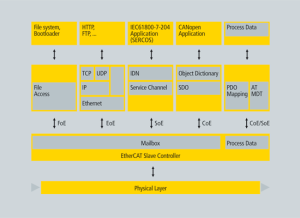Device Profiles
- For many device classes, fieldbus technology already offers reliable device profiles, such as for I/O devices or drives.
- Users are familiar with these profiles and the associated parameters and tools.
- No EtherCAT
 ***EtherCAT is an open, high-performance Ethernet-based fieldbus system. The development goal of EtherCAT was to apply Ethernet to automation applications which require short data update times (also called cycle times) with low communication jitter (for synchronization purposes) and low hardware costs-specific device profiles have been developed for these device classes.
***EtherCAT is an open, high-performance Ethernet-based fieldbus system. The development goal of EtherCAT was to apply Ethernet to automation applications which require short data update times (also called cycle times) with low communication jitter (for synchronization purposes) and low hardware costs-specific device profiles have been developed for these device classes. - Simple interfaces for existing device profiles are offered.
- This greatly assists users and device manufacturers alike during the change from existing fieldbuses
 A Fieldbus is an industrial network system for real-time distributed control (e.g. CAN or Profibus). It is a way of connecting instruments in a plant design to EtherCAT.
A Fieldbus is an industrial network system for real-time distributed control (e.g. CAN or Profibus). It is a way of connecting instruments in a plant design to EtherCAT.
CANopen over EtherCAT (CoE)
CANopen device and application profiles are available for a wide range of device classes and applications.
Devices include I/O components, drives, encoders, proportional valves and hydraulic controllers to application profiles for plastic or textile machinery.
- EtherCAT can provide the same communication mechanisms as the familiar CANopen mechanisms: object dictionary, PDO (process data objects) and SDO (service data objects), and even the network management is comparable.
- EtherCAT can be implemented with minimum effort on devices equipped with CANopen.
- Large parts of the CANopen firmware can be re-used.
- Objects can optionally be expanded in order to account for the larger bandwidth
 In computer networking, bandwidth often refers to a data rate measured in bits/s, for example, network throughput. The reason for the connection of data rate with the term bandwidth is that the limit to the data rate of a physical communication link is related to its bandwidth in hertz offered by EtherCAT.
In computer networking, bandwidth often refers to a data rate measured in bits/s, for example, network throughput. The reason for the connection of data rate with the term bandwidth is that the limit to the data rate of a physical communication link is related to its bandwidth in hertz offered by EtherCAT.
Figure 5-58: Several Device Profiles and Protocols can Coexist







